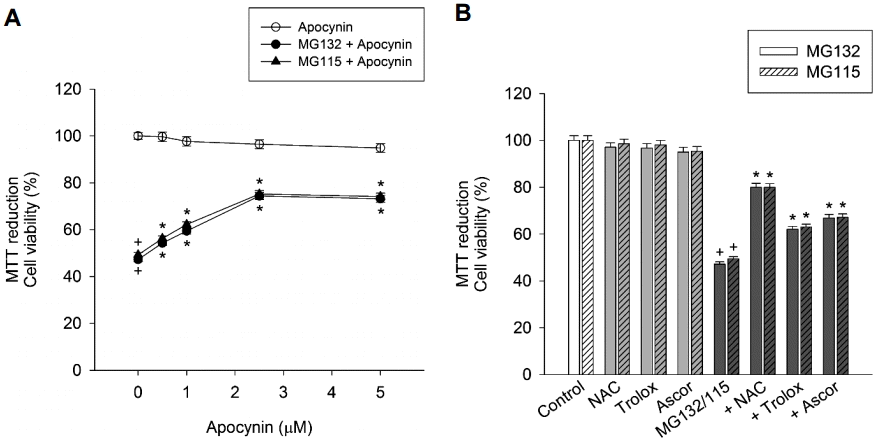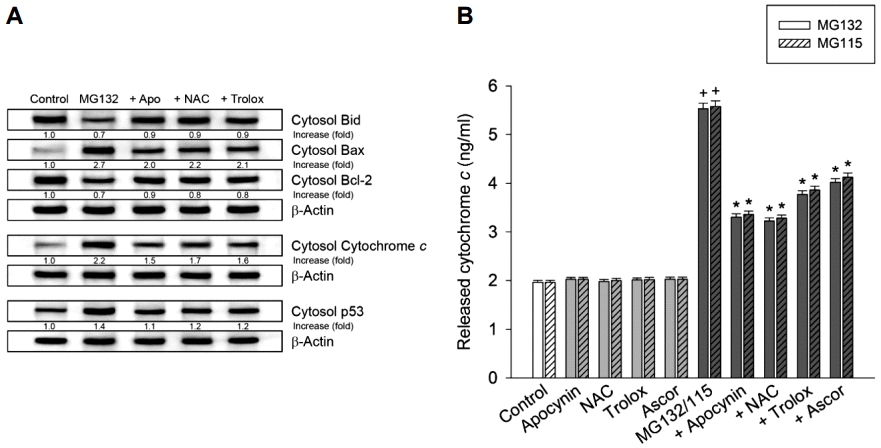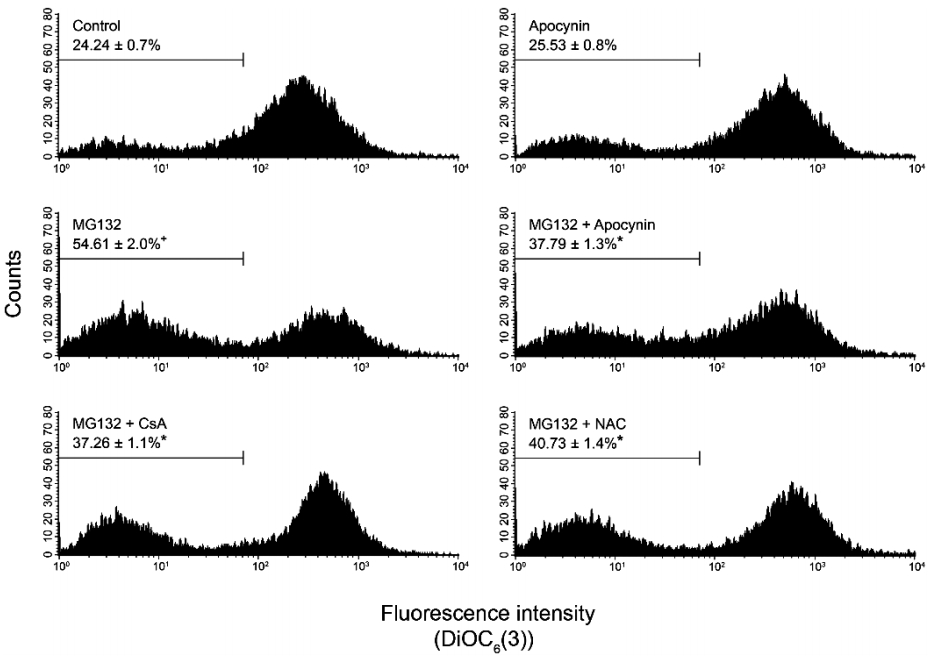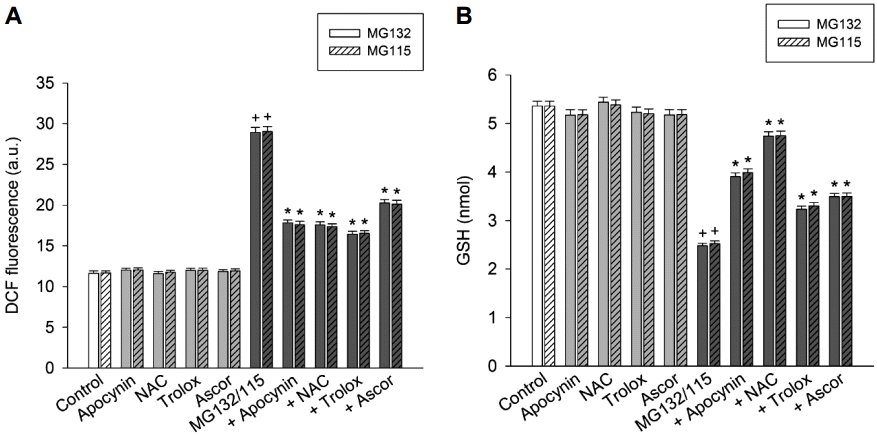서 론
프로테아좀(proteasome)기능이상이 신경퇴행에 관여한다고 알려져 있다[1,2]. 파킨슨병에서 ubiquitin-proteasome기능이상은 프로테아좀의 활성감소, 단백질응집, α-cynuculein대사이상, 사립체기능이상으로 설명하고 있다[1,3]. 프로테아좀 억제제인 lactacystin과 MG132는 배양세포와 동물 파킨슨병 모델에서 α-synuclein의 축적, 도파민의 고갈과 도파민 신경세포의 손상을 일으킨다[4,5]. 프로테아좀 기능을 억제하면 cytochrome c의 방출, caspase의 활성화를 포함한 사립체 매개 세포사멸 과정이 활성화하여 신경세포의 세포자멸사가 나타난다[6-8]. 그러나 프로테아좀 활성의 억제는 신경세포 세포자멸사에 다양한 효과를 나타내며. 프로테아좀 억제에 따른 세포자멸사가 caspase-8-Bid 경로의 활성화에 의해 매개되는지도 분명하지 않다[6,9]. 사립체기능이상에 따라 생성된 활성산소는 사립체 막투과성 변화와 이어서 caspase의 활성화를 일으키며[10], glutathione (GSH)와 같은 세포 내 항산화제를 고갈시킨다[11]. 세포 GSH가 고갈되면 사립체 투과성이 증가하여 세포자멸사 경로가 활성화된다[12,13]. 그러나 proteasome 억제에 의한 세포자멸사가 활성산소에 의해 매개되는지 분명하지 않다[7,9].
Apocynin (4-hydroxy-3-methoxy-acetophenone)은 Picrorhiza kurroa를 포함한 여러 식물에서 얻어지는 천연물로서 체내에서 superoxide 라디칼 생성효소인 nicotinamide adenine dinucleotide phosphate (NADPH)-oxidase (NOX)를 억제하여 유리기와 활성산소 형성을 억제하여 항염증효과를 나타낸다고 알려져 있다[14]. Apocynin은 항산화, 항염증작용에 의해 알츠하이머병, 파킨슨병과 같은 신경퇴행성질환에서 신경세포 기능이상, 변성과 염증에 억제 또는 완화효과를 나타낼 수 있을 것으로 예상하고 있다[15-17].
Apocynin은 gerbil 쥐 해마에서 뇌허혈, 재관류에 따른 산화손상을 억제한다[16]. Apocynin의 활성유도체인 diapocynin은 산화손상과 신경염증반응을 억제하여 파킨슨병 동물모델에서 현저한 신경보호 효과를 나타낸다[17]. Apocynin은 뇌외상에 따른 미세아교세포 활성화와 산화스트레스를 억제한다[18]. Apocynin은 뇌피질 신경세포에서 AßPP변이단백질(V642I-AßPP)의 세포독성을 억제한다고 알려졌다[19].
사립체 기능항진, 항염증, 항산화 능력을 가진 화합물들이 신경세포 손상과 기능이상에 억제효과를 나타낼 수 있다[20]. Apocynin은 항산화, 항염증효과를 가지고 있다고 보고하고 있다. 그러나 apocynin이 프로테아좀 억제에 따른 신경 세포사에 미치는 효과는 밝혀지지 않았다. 본 연구는 신경증식인자로 분화시킨 PC12 세포에서 프로테아좀 억제에 따른 신경세포자멸사에 미치는 apocynin 효과를 세포사 과정의 관점에서 조사하였다.
대상과 방법
1. 세포배양
흰쥐 PC12 세포(pheochromocytoma cell line)를 한국세포주은행에서 구입하여 매뉴얼에 따라 배양하였다. PC12 세포에 100 ng/mL의 7S 신경성장인자(Sigma-Aldrich Inc., 7S Nerve growth factor, St. Louis, MO, USA)를 9일 동안 처리하여 세포를 분화시켰다[21].
2. 세포 생존 분석
세포 생존은 3-(4,5-dimethylthiazol-2-yl)-2,5-diphenyltetrazolium bromide가 미토콘드리아 탈수효소에 의해 포르마진(formazan) 결정체로 전환되는 것을 조사하여 측정하였다[22]. 세포 생존은 화합물을 처리하지 않은 대조군을 100%로 하고 표본 값을 이에 비교하여 %로 표시하였다.
3. 세포자멸사 관련 단백질의 웨스턴블롯 측정
세포자멸사 관련 단백질(Bid, Bax, Bcl-2, cytochrome c, PARP-1, p53)의 양을 웨스턴블롯과 효소결합면역흡착측정법(enzyme-linked immunosorbent assay)으로 조사하였다.
Cytochrome c 유리에 대한 양적분석을 QuantikineⓇ M rat/mouse cytochrome c assay kit (R&D systems, Minneapolis, MN, USA)를 사용하여 시행하였다. 상업용 cytochrome c를 희석하여 표준곡선을 작성하여 분석하고 단백질 μg당 나노몰(nanomole)로 표시하였다.
4. Caspase (-8, -9, -3) 활성 측정
분화된 PC12 세포(2×106 cells/mL)가 포함된 반응액에 프로테아좀 억제제가 포함되거나 들어있지 않은 반응액에 넣어 반응시키고, caspase-3 활성을 caspase-8, caspase-9, caspase-3 활성 측정 키트(R&D systems, Minneapolis, MN, USA)로 분석하였다. 용해된 세포를 원심 분리하고 얻어진 상청액을 dithiothreitol과 caspase(-8, -9, -3)에 대한 기질이 함유되어 있는 혼합액에 넣고 반응시켰다. Chromophore p-nitroanilide의 흡광도를 405 nm에서 측정하였다. 매뉴얼에 따라 caspase 활성을 임의 unit로 표시하였다.
5. 사립체 막전위 측정
PC12세포 함유 반응액에 양이온 지질친화성인 DiOC6(3)를 넣고 flow cytometry로 사립체 막투과 전위의 변화를 측정하였다[23]. 막전위의 변화분석은 argon laser excitation 501 nm에서 FACScan cytofluorometer (Becton Dickinson, San Jose, CA, USA)로 시행하였다.
6. 세포 내 활성산소 생성의 측정
염료 2’,7’-dichlorofluorescein diacetate (DCFH2-DA)가 hydroperoxide와 반응하여 형광물질 2’,7’-dichlorofluorescin (DCF)로 산화되는 것을 조사하여 세포 내 과산화물 양을 측정하였다[24]. 형광광도계를 사용하여 형광의 변화를 여기 파장 485 nm, 방출 파장 530 nm에서 조사하였다.
7. 글루타티온(glutathione)의 총량 측정
글루타티온 총량(환원형 GSH+산화형 이황화글루타티온[glutathione disulfide])은 glutathione reductase를 사용하여 조사하였다[25]. 표준곡선은 상업용 GSH를 희석하여 표준곡선을 작성하여 표본의 양을 결정하였다.
8. 통계 분석
일원배치분산분석 처리하여 얻어진 자료의 통계적 유의성을 검정하였다. 유의성이 확인되면 사후검증으로 특정한 그룹 사이의 비교를 위한 post hoc test를 시행하였다. 자료는 평균 ± 표준오차로 표시하였다. 대조세포에서의 결과에 대한 통계적 유의성; +p<0.05. 프로테아좀 억제제 단독 처리한 세포에서의 결과에 대한 유의성; *p<0.05.
얻어진 자료를 일원배치분산분석 처리하여 통계적 유의성을 확인하였다. 유의성이 검증되면 사후검증으로 다자간 비교를 위한 Duncan’s test를 시행하여 집단간 유의성을 비교하였다. 자료는 평균±표준오차로 표기하였다.
결 과
1. Apocynin이 프로테아좀 억제에 따른 세포손상과 핵손상에 미치는 효과
프로테아좀 억제제 처리에 따른 세포사에 미치는 apocynin의 억제효과를 신경증식인자로 분화시킨 PC12 세포에서 조사하였다. 세포를 25 μM MG132로 처리하였을 때 반응 1시간에 약 53%의 세포사가 나타났다. Apocynin은 MG132 처리에 의한 세포사를 억제하였으며 2.5 μM에서 약 51%의 최대 억제효과를 보였다(Fig. 1A). 다른 프로테아좀 억제제 MG115처리에 따른 세포사에 대해 apocynin이 억제효과를 나타내는지 조사하였다. 50 μM MG115로 24 시간 처리하였을 때 약 51%의 세포가 사멸하였다. Apocynin은 MG115 처리에 따른 세포사를 유의하게 억제하였으며, 2.5 μM에서 최대 억제효과를 나타냈다(Fig. 1A). Apocynin 단독이 5 μM 농도에서 약한(7-9%)의 세포사 효과를 나타내었으나, 프로테아좀 억제제 처리에 따른 세포사를 억제하였다. MG132또는 MG115에 의한 세포자멸사와 apocynin 억제효과가 활성산소 생성에 의해 이루어졌는지 판단하기 위해 프로테아좀억제제 처리에 따른 세포사에 미치는 항산화제의 효과를 조사하였다. 1 mM 티올화합물 N-acetylcysteine, hydroxyl radical과 peroxynitrite 제거제 30 μM trolox, 100 μM ascorbic acid는 프로테아좀억제제 처리에 따른 세포사를 억제하였다(Fig. 1B).
2. Apocynin이 MG132에 의한 세포자멸사 관련 단백질 활성화에 미치는 효과
세포자멸사관련단백질 활성화를 측정하여 MG132 처리에 따른 세포사 과정을 분석하였다. PC12 세포를 MG132로 처리하였을 때 Bid와 세포자멸사유발Bcl-2 양이 감소하였고 세포자멸사 억제 Bax, 세포자멸사유발시토크롬 c, 세포사 촉진 인자 p53 양이 증가하였다(Fig. 2A). Apocynin (2.5 μM)은 MG132 처리에 따른 세포자멸사 관련단백질 양의 변화를 감소시켰다. MG132에 의한 세포자멸사가 활성상소 생성에 의해 이루어지는지 조사하기 위해 항산화제의 효과를 조사하였다. MG132 처리에 따른 세포자멸사관련단백질 양의 변화는 N-acetylcysteine과 trolox 처리에 의해 감소하였다(Fig. 2A).
사립체에서 시토크롬 c 유리에 미치는 apocynin 효과를 양적 분석하였다. 프로테아좀억제제는 PC12 세포 사립체에서 시토크롬 c를 방출시켰다. Apocynin, N-acetylcysteine, trolox, 75 μM ascorbic acid는 MG132 또는 MG115에 의한 시토크롬 c 유리를 억제하였다(Fig. 2B).
MG132 처리에 따른 세포자멸사가 caspase 활성화에 의해 매개되었는지 조사하기 위해 세포사와 caspase 활성화를 측정, 분석하였다. MG132에 의한 세포사는 caspase-8 억제제인 30 μM z-IETD. fmk, caspase-9 억제제인 z-LEHD.fmk, caspase-3 억제제인 30 μM z-DQMD.fmk (모두 30 μM) 처리에 의해 억제되었다(Fig. 3A). Caspase 억제제 단독은 세포생존에 영향을 주지 않았다. MG132를 처리한 PC12 세포에서 caspase (-8, -9, -3)의 활성화를 측정하였다. Apocynin, N-acetylcysteine, trolox, ascorbic acid 는 MG132에 처리에 따른 caspase (-8, -9, -3)의 활성화와 MG115 처리에 따른 의한 caspase-3 활성화를 억제하였다(Fig. 3B and C).
MG132를 처리한 PC12 세포에서 사립체 탈분극 변화를 측정하였다. 세포에 MG132를 처리하였을 때 탈분극(낮은 값의 형광 수치) 상태의 사립체를 가진 세포의 숫자가 증가하였으며, 이는 사립체 막투과 억제제인 0.5 μM 시클로스포린(cyclosporine) A 처리에 의해 감소하였다(Fig. 4). Apocynin과 N-acetylcysteine은 MG132에 의한 사립체막전위 변화를 억제하였다.
3. Apocynin이 MG132 처리에 따른 활성산소 생성과 GSH 고갈에 미치는 효과
프로테아좀 억제에 따른 세포사에 미치는 apocynin의 세포 보호 효과가 산화 스트레스 억제에 의해 이루어졌는지 조사하기 위해 PC12 세포에서 활성산소의 생성과 항산화제의 효과를 측정하였다. 세포 내 활성산소의 생성은 DCFH2-DA가 형광을 내는 DCF로 전환되는 것을 이용하여 분석하였다. PC12 세포를 MG132로 처리하였을 때 DCF 형광이 유의하게 증가하였으며, 이러한 증가는 N-acetylcysteine, trolox, ascorbic acid의 첨가에 의해 억제되었다(Fig. 5A). Apocynin은 MG132 또는 MG115 처리에 따른 DCF 형광의 증가를 억제하였다. 한편 apocynin을 단독 처리한 세포에서 DCF 형광은 대조세포와 비슷하였다.
프로테아좀 억제에 따른 세포사가 세포 GSH 고갈에 의한 것인지 조사하고, GSH 고갈에 미치는 apocynin 효과를 측정하였다. 대조세포에서 티올 양은 단백질 mg 당 5.36 ± 0.10 nanomole이었다. PC12 세포를 MG132 또는 MG115로 24시간 처리하였을 때 티올 양이 약 53% 고갈되었다. Apocynin은 프로테아좀 억제에 따른 GSH 고갈을 억제하였으며, 최대 억제효과가 2.5 μM에서 관찰되었다(Fig. 5B). N-Acetylcysteine, trolox와 ascorbic acid는 프로테아좀 억제제에 의한 GSH 고갈을 억제하였다. 항산화제 단독은 티올 양 변화를 일으키지 않았다.
고 찰
PC12 세포에 신경증식인자를 처리하면 세포에서 신경돌기가 나오며 모양과 신경화학적으로 도파민뉴런과 비슷한 특성을 갖게 된다[26]. PC12 세포는 신경세포에서 세포자멸사 연구에 세포모델로 사용하고 있으며, 세포자멸사관련단백질과 caspase 활성을 갖고 있다[27,28]. 이 연구에서 분화된 PC12 세포에서 프로테아좀 억제제 처리에 따른 세포자멸사는 세포자멸사관련단백질 양의 변화로 설명할 수 있다. 프로테아좀억제제 MG132 또는 MG115를 처리한 PC12 세포에서 Bid, Bcl-2 양의 감소, Bax와 p53 양의 증가, 시토크롬 c 방출, caspase-8, caspase-9, caspase-3 활성화가 유발되었다. 사립체에서 방출된 시토크롬 c는 세포질 pro-caspase-9, 세포자멸사활성인자와 복합체를 이루고 caspase-9으로 활성화를 유발하고 이어서 procaspase-3를 caspase-3로 활성화시킨다[25]. Procaspase- 8은 세포사 수용체와 연계되어 caspase-8로 활성화되고 세포질 단백질 Bid를 분해시킨다. 활성 Bid 분해물은 사립체 막투과성을 증가시키며, 또한 직접 procassape-8 활성화를 통해 caspase-3를 활성화한다[29]. Bax는 사립체 막투과성을 증가시키며, 이와 반대로 Bcl-2, Bcl-xL은 사립체 막투과성을 억제하여 세포자멸사를 억제한다[30,31].
세포자멸사 촉진인자 p53은 DNA 손상과 산화스트레스를 포함한 독성자극 노출에 따른 세포자멸사에 관여한다[29]. p53은 Bax 발현을 증가시키고, 생성된 Bax가 세포사에 이르는 시토크롬 c 유리와 caspase 활성화를 일으킨다[32]. p53은 알츠하이머병, 파킨슨병과 같은 신경퇴행질환에서 신경 세포사에 관여한다고 추정하고 있다[33]. 파킨슨증후군 유발 독소 1-methyl-4-phenyl-1,2,3,6-tetrahydropyridine (MPTP)와 MPTP 대사물질 1-methyl-4-phenylpyridinium을 처리하면 p53 활성화가 나타나며 p53이 세포사와 뇌조직사를 일으킨다[34-36]. 프로테아좀을 억제하면 p53 변성이 억제되어 p53 양이 증가하고 caspase 경로 활성화가 이루어진다[37]. 이러한 연구결과처럼, 분화된 PC12 세포를 MG132로 처리하였을 때 p53 양이 뚜렷하게 증가하였으며, 항산화제 t (Albjhn) poptotic papoptotic p18 by t 억제효과는 프로테아좀 억제가 산화스트레스에 유도된 p53의 활성화시켜 세포자멸사를 일으킨다고 시사한다. 본 연구 결과에서 세포자멸사관련단백질 양의 변화, caspase 활성화는 PC12세포에서 프로테아좀 억제에 따른 세포자멸사가 caspase-8-Bid 경로와 사립체 매개 경로 활성화에 이루어진다는 것을 시사한다.
사립체 막투과성 변경에 이어 사립체 막전위가 붕괴되면 사립체 막투과성 관련 단벡질의 활성화가 나타나고 caspase경로가 활성화한다[38]. 본 실험에서 사립체 막투과성 억제제인 cyclosporin A가 사립체 탈분극에 미치는 억제효과는 MG132가 사립체 막투과성을 변경시켜 시토크롬 c 유리와 caspase 활성화를 유발하여 세포자멸사를 일으킨다는 것을 뒷받침한다.
사립체 기능, 세포 성분보호라는 관점에서 apocynin은 신경 보호 효과를 나타낸다고 알려졌다. Apocynin과 diapocynin은 파킨슨 증후군 유발 독소와 변이 AßPP 단백질에 의한 세포독성을 억제한다[17,19]. 프로테아좀 기능이상이 신경세포 변성에 관여한다고 알려졌다[1,2]. 그러나 프로테아좀 노출에 따른 신경세포 손상과 세포사에 미치는 apocynin효과는 규명되지 않았다. 따라서 본 연구는 분화된 PC12 세포를 이용하여 세포사 경로 관점에서 apocynin이 프로테아좀 억제에 따른 세포자멸사에 미치는 효과를 조사하였다. 본 실험결과에서 apocynin은 프로테아좀 억제에 따른 세포자멸사 관련 단백질양의 변화, 사립체 막투과성의 변화, 시토크롬 c 유리, caspase 활성화, p53 양의 증가를 억제하였다. 실험결과로 apocynin은 사립체 매개 경로와 caspase-8 경로 활성화를 억제하여 프로테아좀 억제에 따른 세포자멸사를 저해할 것으로 생각한다.
독성물질에 노출되어 사립체기능이상이 유발되면 활성산소가 생성된다[10,11]. 생성된 활성산소는 사립체 탈분극, 시토크롬 c 방출, caspase 경로를 활성화한다[11]. 그러나 프로테아좀 억제에 따른 세포사가 활성산소에 의해 이루어지는지 분명하지 않다[7,9]. 본 연구에서 프로테아좀억제제를 처리한 PC12 세포에서 활성산소의 생성과 항산화제 N-acetylcysteine과 trolox의 세포자멸사 억제효과는 프로테아좀억제제가 활성산소 생성을 유발하여 사립체기능이상과 세포사자멸관련단백질 활성화를 일으킨다는 것을 시사한다. 따라서 apocynin은 활성산소생성을 억제하여 프로테아좀 억제제 처리에 따른 세포자멸사를 억제할 것으로 생각한다.
과다 생성된 활성산소는 내 항산화제 GSH, nicotinamide adenine dinucleotide, NADPH의 양을 감소시키게 되고, 이에 따라 사립체기능이상과 세포사가 나타난다[11]. 세포사 초기 현상으로 세포 GSH 고갈 현상이 나타나며 이에 따라 세포자멸사 경로가 활성화된다[39]. 세포 내 GSH가 고갈되면 사립체 탈분극 시토크롬 c 방출, caspase 활성화 과정이 이루어진다[13,39]. 본 실험에서 apocynin은 프로테아좀 억제제에 의해 유발된 활성산소 생성과 고갈을 억제하였다. 따라서 실험결과는 apocynin이 활성산소생성과 GSH 고갈을 억제하여 프로테아좀 억제에 따른 유발된 세포자멸사 과정을 억제함을 보여 주었다.
마취제 propofol이 분화된 PC12 세포에서 과산화수소 처리에 따른 NOX 중심 소단위 gp91phox (NOX2, NADPH oxidase 2) 발현과 NOX 활성화를 억제하여 세포 보호효과를 나타낸다고 알려졌다[40]. 이러한 보고로부터 apcyanin은 NOX2 발현과 NOX 활성화를 억제하여 프로테아좀 억제에 따른 분화된 PC12 세포사에 부분적으로 보호효과를 나타내었을 것으로 예상한다.
결론적으로, 분화된 PC12 세포에서 apocynin은 집행자 caspase 경로 활성화에 이르는 사립체 매개 세포사 경로와 caspase-8 경로 활성화를 억제하여 프로테아좀 억제에 따른 세포자멸사를 억제한다고 생각한다. Apocynin이 세포자멸사 과정에 미치는 저해효과는 활성산소생성 억제와 GSH 고갈을 저해하여 이루어졌을 것으로 생각한다. Apocynin은 프로테아좀 기능이상에 의해 이루어지는 신경세포 퇴행을 저해할 수 있을 것으로 예상한다.








 PDF Links
PDF Links PubReader
PubReader ePub Link
ePub Link Full text via DOI
Full text via DOI Download Citation
Download Citation Print
Print




